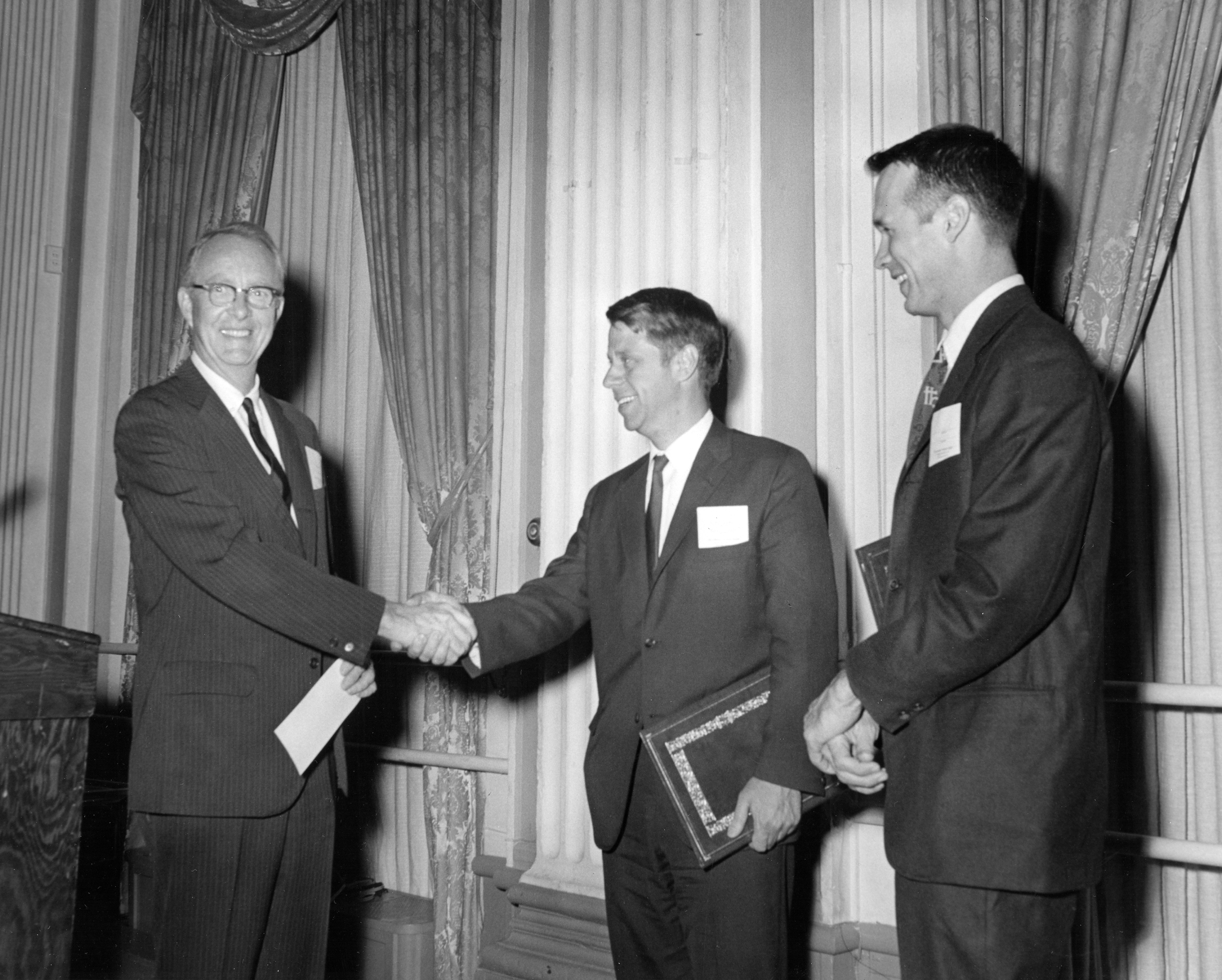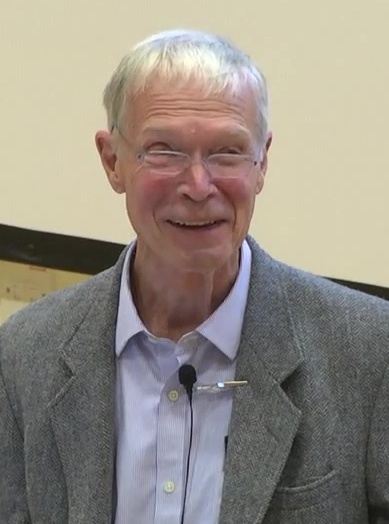1. Overview
John Joseph Hopfield (born July 15, 1933) is a distinguished American physicist and neuroscientist, widely recognized for his groundbreaking interdisciplinary research. His work spans condensed matter physics, biophysics, computational neuroscience, and artificial intelligence (AI). In 2024, he was jointly awarded the Nobel Prize in Physics with Geoffrey Hinton for "foundational discoveries and inventions that enable machine learning with artificial neural networks." Hopfield's most significant contribution to AI is the development of the Hopfield network in 1982, an associative neural network that played a crucial role in revitalizing interest in the field during a period known as the AI winter. His innovative approach, integrating principles from physics into the study of biological and artificial systems, has profoundly influenced multiple scientific disciplines and laid essential groundwork for modern AI.
2. Biography
John Joseph Hopfield's life and career are marked by a deep engagement with diverse scientific fields, stemming from his early education and family background.
2.1. Early life, family, and education
John Joseph Hopfield was born on July 15, 1933, in Chicago, Illinois. His parents, John Joseph Hopfield (born Jan Józef Chmielewski in Poland) and Helen Hopfield (née Staff), were both physicists, which likely influenced his early academic inclinations.
He pursued his higher education at Swarthmore College in Pennsylvania, where he earned a Bachelor of Arts degree in physics in 1954. He then continued his studies at Cornell University, completing his Doctor of Philosophy in physics in 1958. His doctoral dissertation was titled "A quantum-mechanical theory of the contribution of excitons to the complex dielectric constant of crystals," and his doctoral advisor was Albert Overhauser.
3. Career
Hopfield's professional journey demonstrates a remarkable ability to transition between and integrate various scientific disciplines, leaving a significant impact at leading research institutions and universities.
3.1. Early career and research
After completing his doctorate, Hopfield spent two years in the theory group at Bell Laboratories. During this period, he focused on the optical properties of semiconductors, collaborating with David Gilbert Thomas. Later, he worked with Robert G. Shulman to develop a quantitative model describing the cooperative behavior of hemoglobin. In 1976, he participated in a science short film on the structure of hemoglobin, which also featured Linus Pauling.
3.2. Academic appointments
Hopfield's academic career includes faculty positions at several prestigious universities. He served as a physics faculty member at the University of California, Berkeley from 1961 to 1964. He then moved to Princeton University, where he taught physics from 1964 to 1980. From 1980 to 1997, he was a professor of chemistry and biology at the California Institute of Technology (Caltech). He returned to Princeton University in 1997, where he now holds the title of Howard A. Prior Professor of Molecular Biology, emeritus.
From 1981 to 1983, Hopfield collaborated with renowned physicists Richard Feynman and Carver Mead to teach a year-long course at Caltech titled "The Physics of Computation." This collaboration was instrumental in inspiring the creation of the Computation and Neural Systems (CNS) PhD program at Caltech in 1986, which Hopfield co-founded.
3.3. Doctoral students
Throughout his extensive academic career, John Hopfield has mentored numerous doctoral students who have gone on to make significant contributions to their respective fields. His former PhD students include:
- Gerald Mahan (PhD 1964)
- Bertrand Halperin (PhD 1965)
- Steven Girvin (PhD 1977)
- Terry Sejnowski (PhD 1978)
- José Onuchic (PhD 1987)
- Li Zhaoping (PhD 1990)
- David J. C. MacKay (PhD 1992)
- Erik Winfree (PhD 1998)
4. Scientific Contributions
John Joseph Hopfield's scientific contributions span an impressive range of disciplines, demonstrating his unique ability to apply physical principles to complex biological and computational problems.
4.1. Condensed matter physics and quantum mechanics
Hopfield's foundational work in physics began with his doctoral research in 1958, where he investigated the interaction of excitons in crystals. In this work, he coined the term "polariton" to describe a quasiparticle that emerges in solid-state physics, representing a coupled state of a photon and an exciton. This concept is sometimes referred to as the Hopfield dielectric model.
Between 1959 and 1963, Hopfield, in collaboration with David G. Thomas, conducted extensive research on the exciton structure of cadmium sulfide by analyzing its reflection spectra. Their experimental and theoretical models significantly advanced the understanding of the optical spectroscopy of II-VI semiconductor compounds.
Beyond his direct publications, Hopfield was acknowledged by condensed matter physicist Philip W. Anderson as a "hidden collaborator" for Anderson's seminal works from 1961 to 1970 on the Anderson impurity model, which provided an explanation for the Kondo effect. Although not a co-author on these papers, Anderson consistently recognized the critical importance of Hopfield's contributions in his writings. In 1973, Hopfield also collaborated with William C. Topp to introduce the concept of norm-conserving pseudopotentials, which are fundamental in modern electronic structure calculations.
4.2. Biophysics and biochemical systems
Hopfield's interdisciplinary approach extended into biophysics, where he made significant contributions to understanding the mechanisms of biological processes. His early work at Bell Laboratories included developing a quantitative model for the cooperative behavior of hemoglobin, a protein responsible for oxygen transport in blood.
In 1974, he introduced the concept of "kinetic proofreading" as a mechanism for error correction in biochemical reactions. This theory explained how biological systems, such as those involved in DNA replication, achieve remarkably high accuracy by introducing an additional kinetic step that allows for the rejection of incorrect substrates, thereby reducing errors in biosynthetic processes that require high specificity.
4.3. Neural networks and artificial intelligence
Hopfield's most widely recognized contribution is his pioneering work in neural networks, which profoundly impacted the field of artificial intelligence. In 1982, he published his seminal paper, "Neural networks and physical systems with emergent collective computational abilities." In this paper, he introduced what is now known as the Hopfield network, a type of associative neural network composed of binary neurons that can be either 'on' or 'off'. This network functions as a content-addressable memory, capable of retrieving complete patterns from incomplete or noisy inputs. The inspiration for the Hopfield network, as he later stated, came from his knowledge of spin glasses, a concept from condensed matter physics, which he gained through his collaborations with P. W. Anderson.
The 1982 paper was pivotal in revitalizing interest in artificial intelligence, which was then experiencing a period of decline. He further extended his formalism in 1984, demonstrating that neurons with continuous activation functions could also exhibit collective computational properties similar to those of two-state neurons. These two papers represent his most highly cited works.
In 1985-1986, working with David W. Tank, Hopfield developed a method for solving discrete optimization problems using the continuous-time dynamics of a Hopfield network. This approach involved encoding the optimization problem within the network's interaction parameters (weights) and gradually decreasing the effective temperature of the analog system, akin to global optimization techniques like simulated annealing.
The original Hopfield networks had limitations in terms of memory capacity. This issue was addressed by Hopfield and Dimitry Krotov in 2016, leading to the development of what are now known as modern Hopfield networks, which significantly enhance memory storage capabilities for pattern recognition.
4.4. Computational neuroscience and complex systems
Hopfield has also made substantial contributions to computational neuroscience and the study of complex systems, particularly in understanding how the brain performs computations. He is recognized as one of the pioneers of the critical brain hypothesis. In 1994, he was the first to establish a link between neural networks and self-organized criticality, drawing parallels to models for earthquakes, such as the Olami-Feder-Christensen model.
Furthering this research, in 1995, Hopfield and Andreas V. Herz demonstrated that avalanches in neural activity exhibit a power law distribution, similar to those observed in earthquakes. His work also explored how the brain processes information, including his contributions to understanding the principles of computation in olfaction, suggesting a unique collective organizing principle in the sense of smell and a new mechanism for neural function to leverage the temporal structure of spiking interneural communication.
5. Views on Artificial Intelligence
John Joseph Hopfield has expressed significant reflections and concerns regarding the rapid advancements in artificial intelligence, particularly in the context of AI safety and its potential societal impact.
In March 2023, Hopfield was among over 30,000 individuals, including prominent AI researchers like Yoshua Bengio and Stuart J. Russell, who signed an open letter titled "Pause Giant AI Experiments." This letter called for a temporary halt to the training of AI systems more powerful than GPT-4, citing risks such as human obsolescence and a potential society-wide loss of control over advanced AI.
Upon being awarded the 2024 Nobel Prize in Physics, Hopfield publicly stated that he was "very unnerved" by the recent capabilities of AI. He emphasized his concern as a physicist, remarking, "I'm very unnerved by something which has no control." In a subsequent press conference at Princeton University, he drew a comparison between the current state of AI development and the discovery of nuclear fission, highlighting how a groundbreaking scientific advance could lead to both beneficial technologies like nuclear power and destructive ones like nuclear weapons, underscoring the urgent need for careful management and control.
6. Awards and Honors
John Joseph Hopfield has received numerous prestigious awards, fellowships, and recognitions throughout his career, acknowledging his profound impact across physics, biology, neuroscience, and computer science.

His honors include:
- 1962**: Sloan Research Fellowship
- 1968**: Guggenheim Fellowship
- 1969**: Oliver E. Buckley Prize of condensed matter physics, awarded by the American Physical Society (APS) jointly with David Gilbert Thomas for their combined theoretical and experimental work that advanced the understanding of light's interaction with solids.
- 1973**: Elected member of the National Academy of Sciences.
- 1975**: Elected member of the American Academy of Arts and Sciences.
- 1983**: MacArthur Foundational Prize.
- 1985**: Golden Plate Award of the American Academy of Achievement.
- 1985**: Max Delbruck Prize in Biophysics, awarded by the APS.
- 1988**: Elected member of the American Philosophical Society.
- 1988**: Michelson-Morley Award by Case Western Reserve University.
- 1997**: Neural Networks Pioneer Award by the Institute of Electrical and Electronics Engineers (IEEE).
- 2001**: Dirac Medal of the International Centre for Theoretical Physics (ICTP) for his significant contributions across a broad spectrum of scientific subjects, including a new organizing principle in olfaction and a new principle for neural function utilizing the temporal structure of spiking interneural communication.
- 2002**: Harold Pender Award for his accomplishments in computational neuroscience and neural engineering from the Moore School of Electrical Engineering, University of Pennsylvania.
- 2005**: Albert Einstein World Award of Science in the field of life sciences.
- 2006**: Served as the President of the American Physical Society.
- 2009**: IEEE Frank Rosenblatt Award for his contributions to understanding information processing in biological systems.
- 2012**: Swartz Prize by the Society for Neuroscience for his contributions to computational neuroscience.
- 2019**: Benjamin Franklin Medal in Physics by the Franklin Institute.
- 2022**: Boltzmann Medal in statistical physics, shared with Deepak Dhar.
- 2024**: Nobel Prize in Physics, jointly with Geoffrey E. Hinton, for "foundational discoveries and inventions that enable machine learning with artificial neural networks."
- 2025**: Queen Elizabeth Prize for Engineering, jointly with Yoshua Bengio, Bill Dally, Geoffrey E. Hinton, Yann LeCun, Jen-Hsun Huang, and Fei-Fei Li for the development of modern machine learning.


7. External links
- [http://genomics.princeton.edu/hopfield/Index.html Homepage at Princeton]
- [http://www.scholarpedia.org/article/User:Hopfield John J. Hopfield - Scholarpedia]
- [https://www.nobelprize.org/prizes/physics/2024/summary/ Nobel Prize in Physics 2024 information]
- [https://doi.org/10.1146/annurev-conmatphys-031113-133924 "Whatever Happened to Solid State Physics?" (2014) - A review by John J. Hopfield tracing the trajectory of solid state physics through his experiences.]
- [https://pni.princeton.edu/people/john-j-hopfield/now-what "Now What?" (2018) - An auto-biographical essay by John Hopfield on the Princeton Neuroscience Institute website.]
- [https://api.nakala.fr/data/11280%2F5fd45598/9965ea09d6b94c0fdf8123f70e9e019719c192b3 "History of RSB Interview: John J. Hopfield"] (2020) - Transcript of an oral history conducted by Patrick Charbonneau and Francesco Zamponi.
- [https://www.nobelprize.org/prizes/physics/2024/hopfield/facts/ John Hopfield Facts] from the Nobel Foundation.
- [https://qeprize.org/winners/modern-machine-learning Queen Elizabeth Prize for Engineering 2025]